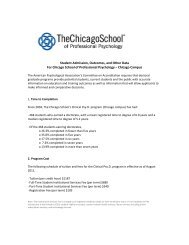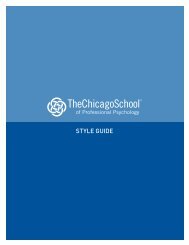Center for Academic Excellence Writing Assessment ... - eGo Main
Center for Academic Excellence Writing Assessment ... - eGo Main
Center for Academic Excellence Writing Assessment ... - eGo Main
You also want an ePaper? Increase the reach of your titles
YUMPU automatically turns print PDFs into web optimized ePapers that Google loves.
The Atlantic Online | June 2009 | What Makes Us Happy? | Joshua Wolf Shenk<br />
12/31/09 10:15 PM<br />
a “temple” to Freud’s ideas. He learned the orthodoxy, which included a literary approach to human lives, bringing theory to<br />
bear through deep reading of individual cases. But he also had training in the rigors of data-driven experimental science,<br />
including a two-year fellowship at a Skinnerian laboratory, where he studied neurotransmitter levels in pigeons and<br />
monkeys. There he learned to use the behaviorist B. F. Skinner’s “cumulative behavioral recorder,” which collapses<br />
behaviors across minutes, hours, or days onto a chart to be inspected in a single sitting.<br />
The undertones of psychoanalysis are tragic; Freud dismissed the very idea of “normality” as “an ideal fiction” and famously<br />
remarked that he hoped to trans<strong>for</strong>m “hysterical misery into common unhappiness.” The spirit of modern social science, by<br />
contrast, draws on a brash optimism that the secrets to life can be laid bare. Vaillant is an optimist marinated in tragedy, not<br />
just in his life experience, but in his taste. Above his desk hangs a letter from a group of his medical residents to their<br />
successors, advising them to prepare <strong>for</strong> Vaillant’s “obscure literary references” by reading Tennessee Williams’s The Glass<br />
Menagerie, Arthur Miller’s Death of a Salesman, and Henrik Ibsen’s A Doll’s House. Vaillant loves Dostoyevsky and<br />
Tolstoy, too, and the cartoons of the dark humorist Charles Addams, like the one where several Christmas carolers sing<br />
merrily at the Addams family doorstep, while Morticia, Lurch, and Gomez stand on the roof, ready to tip a vat of hot oil on<br />
their heads. When his children were small, Vaillant would read them a poem about a tribe of happy-go-lucky bears, who<br />
lived in a kind of Eden until a tribe of mangier, smarter bears came along and enslaved them. “I would weep at this story,”<br />
remembers his daughter Anne Vaillant. “Dad thought it was funny, and I think somehow it was helpful to him that I had<br />
such feelings about it. There was this sort of, ‘This is the way life is.’”<br />
Yet, even as he takes pleasure in poking holes in an innocent idealism, Vaillant says his hopeful temperament is best<br />
summed up by the story of a father who on Christmas Eve puts into one son’s stocking a fine gold watch, and into another<br />
son’s, a pile of horse manure. The next morning, the first boy comes to his father and says glumly, “Dad, I just don’t know<br />
what I’ll do with this watch. It’s so fragile. It could break.” The other boy runs to him and says, “Daddy! Daddy! Santa left<br />
me a pony, if only I can just find it!”<br />
The story gets to the heart of Vaillant’s angle on the Grant Study. His central question is not how much or how little trouble<br />
these men met, but rather precisely how—and to what effect—they responded to that trouble. His main interpretive lens has<br />
been the psychoanalytic metaphor of “adaptations,” or unconscious responses to pain, conflict, or uncertainty. Formalized<br />
by Anna Freud on the basis of her father’s work, adaptations (also called “defense mechanisms”) are unconscious thoughts<br />
and behaviors that you could say either shape or distort—depending on whether you approve or disapprove—a person’s<br />
reality.<br />
Vaillant explains defenses as the mental equivalent of a basic biological process. When we cut ourselves, <strong>for</strong> example, our<br />
blood clots—a swift and involuntary response that maintains homeostasis. Similarly, when we encounter a challenge large or<br />
small—a mother’s death or a broken shoelace—our defenses float us through the emotional swamp. And just as clotting can<br />
save us from bleeding to death—or plug a coronary artery and lead to a heart attack—defenses can spell our redemption or<br />
ruin. Vaillant’s taxonomy ranks defenses from worst to best, in four categories.<br />
At the bottom of the pile are the unhealthiest, or “psychotic,” adaptations—like paranoia, hallucination, or megalomania—<br />
which, while they can serve to make reality tolerable <strong>for</strong> the person employing them, seem crazy to anyone else. One level up<br />
are the “immature” adaptations, which include acting out, passive aggression, hypochondria, projection, and fantasy. These<br />
http://www.theatlantic.com/doc/print/200906/happiness<br />
Page 7 of 20





